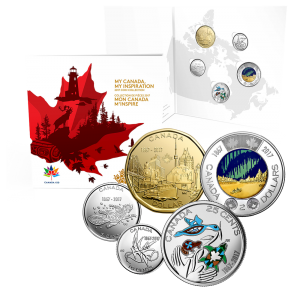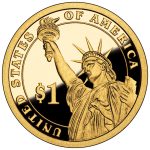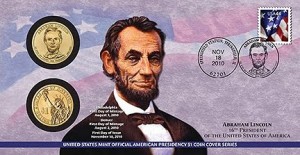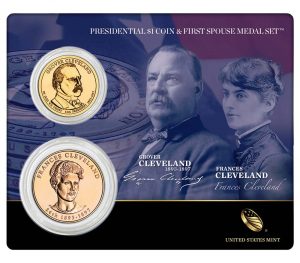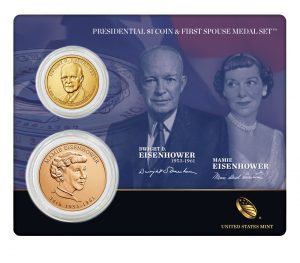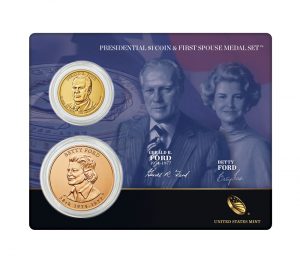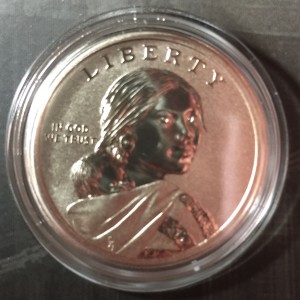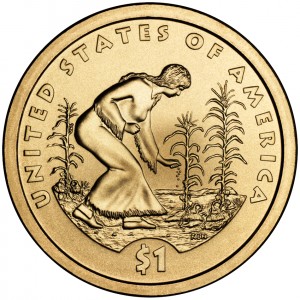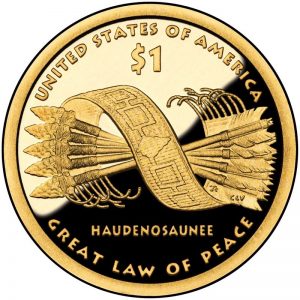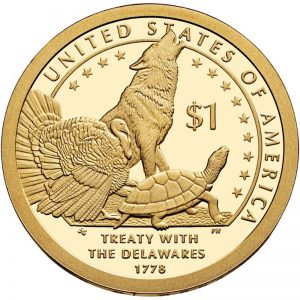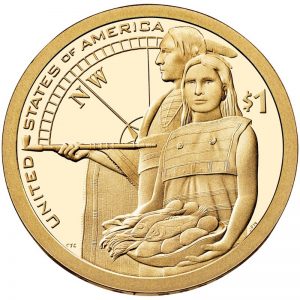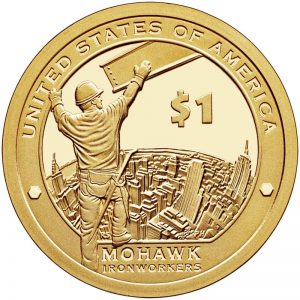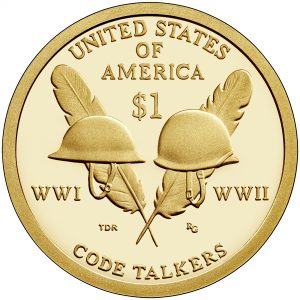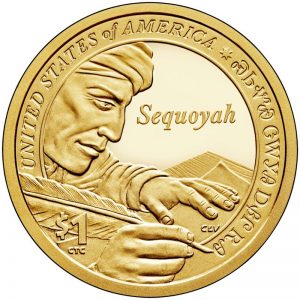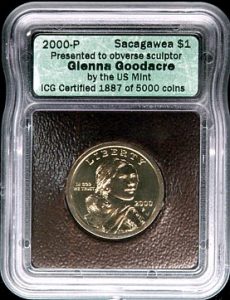The U.S. Mint has a memory problem
This is the second article of three regarding the recent problems at the U.S. Mint.

It is as if the U.S. Mint did not learn a lot since the fiasco of the 2014 Kennedy Half Dollar 50th Anniversary Gold Coin release. (Image courtesy of ABC 7 News, Denver)
Last month, a discussion was held with a representative of the U.S. Mint’s communications department and a manufacturing supervisor to understand better the 2021 Morgan Dollar ordering failures. When asked about lessons learned from previous sales, they admitted to working at the U.S. Mint for four years or less and could not talk about previous issues.
After asking about lessons learned from the past with responses ringing like “not on my watch,” it brought to mind the first Numismatic Forum in 2016, where the only blogger in attendance asked whether the discussions would survive changes of leadership and administrations. Rhett Jeppson was nominated to be Director of the U.S. Mint but was never confirmed. Although there were three more Numismatic Forums, it is apparent that none of the discussions survived leadership changes.
Part of the problem is with the government’s Senior Executive Service (SES) program. Members of the SES are government employees hired to senior management positions within the federal government. They undergo special training in government leadership and understand how to lead their sections through policy changes. SES employees are supposed to be non-partisan government workers. There are also limited reasons for the SES to stay with the agency to build collective knowledge.
There are three ways an SES employee can be appointed. A career appointment is a merit position staffed by a qualified executive. A noncareer appointment is a temporary appointment and is subject to several restrictions, including the number of temporary appointees the government can hire. Finally, a limited appointment is hired for an 18 month to a three-year term. Rhett Jeppson’s role that made him the acting Director was the result of a limited appointment.
SES members are also encouraged to change agencies every four years. Although there are exceptions, the SES program is designed not to allow executives to become too powerful within the agencies. Forcing them to move reduces the risk of potential abuse of power.
As SES members come and go, the U.S. Mint loses the institutional knowledge they earned over the years. Experience working with members of the SES program shows that the new appointees rarely refer to documentation left by their predecessors. Their egos also have them ignoring employees and contractors with the institutional knowledge.
The U.S. Mint has resources in the numismatic community that can help teach them about the past. Having an engaged numismatic community available to help the U.S. Mint makes the bureau unique among government agencies. If their egos prevent them from reaching out to the numismatic community, the SES members can perform a web search on any topic to read what the numismatic press wrote about any issue.
During the discussion, the U.S. Mint emphasized how they wanted to work with the numismatic community and do their best to make the products accessible. While they will talk with members of the numismatic media, the U.S. Mint will not reach out for the community’s help.
The numismatic community wants the U.S. Mint to be able to support our collecting habits. They have a unique opportunity to engage a community willing to help. If the U.S. Mint wants to demonstrate that they are, they should set up a program of numismatic advisors to help them understand what went wrong in the past and how to make it better for the future.
HAPPY CANADA DAY!

Canada Day, or Fête du Canada in the French-speaking areas, is Canada’s version of Independence Day. It celebrates the enactment of their Constitution on July 1, 1867. The Constitution Act of 1867 brought together Ontario, Quebec, Nova Scotia, and New Brunswick to create the Dominion of Canada. As a Dominion then an independent member of the Commonwealth Realm, Canadian history is a bit different from that of the United States but as interesting.
This year, Canada celebrates its 150th Anniversary. Joining in the celebration, the Royal Canadian Mint has been issuing many collector coins with various themes for collectors to celebrate. One of the most talked about coins is the circulating $2 coin called “Dance of the Spirits” that features the Northern Lights that glow in the dark.
- Reverse design of the 2017 Canada $2 “Dance of the Spirits” circulating coin
- What the 2017 Canada $2 “Dance of the Spirits” reverse would look like in the dark
Collectors can purchase a 5-coin set of uncirculated Canada 150 circulation strike coins in a special folder from the Royal Canadian Mint for $19.95 CAD (currently $15.39 USD). For those who want the full set of uncirculated coins, the complete 12-coin set is available for $34.95 CAD ($26.95 USD).
- 2017 Canada 150 5-Coin Collection
- 2017 Canada 150 Circulation 12-Coin Collection
If you can wait, the Royal Canadian Mint is scheduled to attend the World’s Fair of Money. Sometimes they offer discounts to those attending the show and they could be sold out of these sets! But if you are not going to make it to Denver, the Royal Canadian Mint is very good with shipping to the United States.
- Canada Day banner courtesy of the Government of Canada.
- All coin images courtesy of the Royal Canadian Mint
June 2017 Numismatic Legislation Review
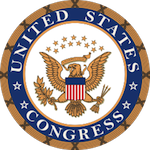 There are people who love front row seats. They go out of their way to find tickets in the front row. Whether it is a concert, the latest play, or the movies the front row gets you up close and personal.
There are people who love front row seats. They go out of their way to find tickets in the front row. Whether it is a concert, the latest play, or the movies the front row gets you up close and personal.
The front row is also louder. Because it is a desirable seat, the front row is crowded. You can get pushed around, cramped and you’re not going to tell the show to turn down the volume a bit. Many times, there are those who think they deserve the special perks of the front row even if they are the ordinary shlub off the street.
This is what it is like living around the nation’s capital. For a political junkie, this is the front row of politics. Even though more work is happening in state capitols, everyone crowds the front row. With the lure of the show, this front row is crowded, loud, and there are a lot of people who are inconsiderate and crowding the theater making it no longer fun.
When I started writing about numismatic legislation, it was interesting. It was fun going through the bills to find interesting stories and speculate whether it will pass. Now with all the garbage eliminating from both ends of Pennsylvania Avenue, I am finding it difficult to stay interested. The rhetoric and level of nonsense have turned the show from being tuneful to sound worse than the sound of two chalkboards mating.
I hope that something changes soon because there have been some interesting numismatic-related bills introduced that would be nice to see passed.
S. 1326: American Innovation $1 Coin Act
This bill can be tracked at http://bit.ly/115-S1326.
S. 1503: A bill to require the Secretary of the Treasury to mint coins in recognition of the 60th anniversary of the Naismith Memorial Basketball Hall of Fame
This bill can be tracked at http://bit.ly/115-S1503.
Collecting Small Dollars: Presidential Dollars
- The Susie B
- The Golden Dollar
- Native American Dollars
- Presidential Dollar Series ← you are here
For the first time in the modern era the date, mintmark, and mottos “E PLURIBUS UNUM” and “IN GOD WE TRUST” struck into (incuse) the edge of the coin. The last time edge lettering was used on circulating U.S. coinage was in the 1830s.
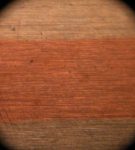
Altered Washington Dollar Edge. Read more here
If you are going to buy Presidential dollars with missing edge lettering, it is advisable to buy them encapsulated by a third-party grading service. After the error was discovered, unscrupulous people began to file the edges of the coin in an attempt to fool collectors. The third-party grading services know how distinguish the legitimate error versus the fake.
Other collectible edge errors include the doubling of the lettering. When encapsulated by the grading services, it is called either “DOUBLE EDGE LETTERING” or “OVERLAPPED LETTERING” depending on the service. Doubled lettering is a rarer mistake than missing edge lettering. Similar to the missing edge lettering error, there has been attempts to alter coins to make it look like they have these errors which it is advisable to buy these coins encapsulated by a third-party grading service.
If you are looking for different ways of collecting Presidential Dollars, the U.S. Mint offered First Day Covers for each of the presidents. Each colorful cover includes the stamp of the day postmarked from the capital or city the president was from on the first day that the coins were issued. They also include one uncirculated Presidential dollar struck on the first day of production. These first day covers are the only way to guarantee that you own coins that were struck on the first day of their production. With information about each president, it makes for an attractive set.
- 2010 Lincoln First Day Cover (before branding)
- 2011 Andrew Johnson First Day Cover (after branding)
Another option to collecting Presidential Dollars is to collect the coin and medal set. Each specially produced card includes an uncirculated dollar for each president and a 1.5-inch bronze medal of the corresponding first spouse coin. The only difference in design between the medal in this set and the first spouse coin is the medal does not have a denomination. If the president was widowed or not married at the time of his presidency, a special Liberty gold coin was produced. The coin and medal set contains a medal similar to the gold coin. Remember, John Tyler and Woodrow Wilson became widows and then remarried during their term. There are two cards for each president with different first spouse medals.
- 2012 Grover Cleveland second administration Dollar & Frances Cleveland Medal Set
- 2015 Dwight D. Eisenhower Dollar & Maine Eisenhower Medal
- 2016 Gerald Ford Dollar & Betty Ford Medal
Series Details
Presidential Dollars
- 2007:
- George Washington, John Adams, Thomas Jefferson, James Madison
- 2008:
- James Monroe, John Quincy Adams, Andrew Jackson, Martin Van Buren
- 2009:
- William Henry Harrison, John Tyler, James K. Polk, Zachary Taylor
- 2010:
- Millard Fillmore, Franklin Pierce, James Buchanan, Abraham Lincoln
- 2011:
- Andrew Johnson, Ulysses S. Grant, Rutherford B. Hayes, James Garfield
- 2012:
- Chester A. Arthur, Grover Cleveland, Benjamin Harrison, Grover Cleveland
- 2013:
- William McKinley, Theodore Roosevelt, William Howard Taft, Woodrow Wilson
- 2014:
- Warren Harding, Calvin Coolidge, Herbert Hoover, Franklin D. Roosevelt
- 2015:
- Harry S Truman, Dwight D. Eisenhower, John F. Kennedy, Lyndon B. Johnson
- 2016:
- Richard M. Nixon, Gerald Ford, Ronald Reagan
First Spouse Gold $10 Coins
- 2007:
- Martha Washington, Abigail Adams, Thomas Jefferson’s Liberty,† Dolley Madison
- 2008:
- Elizabeth Monroe, Louisa Adams, Andrew Jackson’s Liberty,† Martin Van Buren’s Liberty†
- 2009:
- Anna Harrison, Letitia Tyler,‡ Julia Tyler,†† Sarah Polk, Margaret Taylor
- 2010:
- Abigail Fillmore, Jane Pierce, James Buchanan’s Liberty,* Mary Lincoln
- 2011:
- Eliza Johnson, Julia Grant, Lucy Hayes, Lucretia Garfield
- 2012:
- Alice Paul,¶ Frances Cleveland (first term), Caroline Harrison,‡ Frances Cleveland (second term)
- 2013:
- Ida McKinley, Edith Roosevelt, Helen Taft, Ellen Wilson,‡ Edith Wilson††
- 2014:
- Florence Harding, Grace Coolidge, Lou Hoover, Anna Eleanor Roosevelt
- 2015:
- Elizabeth Truman, Mamie Eisenhower, Jacqueline Kennedy, Claudia Taylor “Lady Bird” Johnson
- 2016:
- Patricia Ryan “Pat” Nixon, Betty Ford, Nancy Reagan
- †
- President was widowed prior to inauguration
- ‡
- First Spouse died during the president’s term
- ††
- Married the president during the president’s term
- *
- James Buchanan was the only bachelor president
- ¶
- President Chester Arthur was widowed prior to inauguration. However, the authorizing law gives the coin honor to Alice Paul, a suffragette who was born during Arthur’s administration
The Presidential Dollar series covered 39 presidents representing 40 terms were issued.
Along side of the presidents, there have been 35 first spouses were honored (Frances Cleveland appeared twice), four different Liberty coins were issued, and one First Spouse coin was issued to honor suffragette Alice Paul.
- Coin images courtesy of the U.S. Mint.
- Image of altered edge dollar courtesy of Numismatic Guarantee Corporation.
Collecting Small Dollars: Native American Dollars
- The Susie B
- The Golden Dollar
- Native American Dollars ← you are here
- Presidential Dollar Series
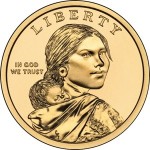 As part of the law that created the Presidential $1 Coins, congress authorized the creation of the Native American dollars. The law says that the obverse would continue to feature the portrait of Sacagawea and the revers depict “images celebrating the important contributions made by Indian tribes and individual Native Americans to the development of the United States and the history of the United States.” Selection of the theme is to be made in consulting with the U.S. Senate Committee on Indian Affairs, the Congressional Native American Caucus of the U.S. House of Representatives, the U.S. Commission of Fine Arts and the National Congress of American Indians, and after public review by the Citizens Coinage Advisory Committee.
As part of the law that created the Presidential $1 Coins, congress authorized the creation of the Native American dollars. The law says that the obverse would continue to feature the portrait of Sacagawea and the revers depict “images celebrating the important contributions made by Indian tribes and individual Native Americans to the development of the United States and the history of the United States.” Selection of the theme is to be made in consulting with the U.S. Senate Committee on Indian Affairs, the Congressional Native American Caucus of the U.S. House of Representatives, the U.S. Commission of Fine Arts and the National Congress of American Indians, and after public review by the Citizens Coinage Advisory Committee.
Although the law required Sacagawea to remain on the obverse, the date, mintmark and the motto “E PLURIBUS UNUM” were relocated to the edge of the coin.
Aside from being thoughtful themes, the designs have been met with critical acclaim by the Native American interest groups, historians, and artists. As part of the program, the U.S. Mint has created lesson plans for teachers to use as supplementary material for their classes that coordinate with the release of the coins. These materials show how the lessons fit within the Common Core education requirements.
The Native American $1 Program is a straight forward series. Each year the reverse changes for the chosen theme. Business strike coins are struck in Philadelphia and Denver while proof coins are struck in San Francisco.
For collectors of special sets, the U.S. Mint includes the Native American $1 coin in the Annual Uncirculated Dollar Coin Set. These sets also include the uncirculated Presidential $1 Coins (through 2016) and an uncirculated American Silver Eagle coin that was minted at West Point. The American Silver Eagle is the collector version, not the bullion coin that is sold through investment channels.
Since 2014, the U.S. Mint has produced a Coin and Currency Set that includes a proof Native American $1 Coin and a $1 Federal Reserve Note in the most recently issued series printed by the Bureau of Engraving and Printing. The coin and note are attached to a folder with information about the theme of the coin. In 2015, the Mohawk Ironworkers coin was struck as an enhanced uncirculated coin minted in West Point and included a Federal Reserve Note from the Federal Reserve Bank of New York. Since the Mohawk Ironworkers were depicted as helping build the New York skyline, it was deemed appropriate to pair the coin with a Federal Reserve Note also from New York.
- Obverse of the 2015-W Enhanced Uncirculated Native American Dollar from the 2015 $1 Set
- 2015-W Native American Dollar Enhanced Uncirculated Reverse celebrating the Mohawk Iron Workers
Reverse Designs
- 2009: Spread of Three Sisters Agriculture (1000 A.D.)
- 2010: Great Tree of Peace (early 1400s)
- 2011: Diplomacy—Treaties with Tribal Nations
- 2012: Trade and Economy
- 2013: Delaware Treaty of 1778
- 2014: Native Hospitality Ensured the Success of the Lewis and Clark Expedition
- 2015: Mohawk high iron workers, builders of New York City and other skylines
- 2016: Code Talkers from both World War I and World War II
- 2017: Sequoyah: George Gist, Cherokee (1776-1843)
Future Designs
Currently, the following reverse themes have been approved for future Native American $1 coins:
- 2018: Jim Thorpe
- 2019: Native Americans in Space
- 2020: Anti-Discrimination Act of 1945
In the last installment, we look at Presidential Dollars.
Collecting Small Dollars: The Golden Dollar
- The Susie B
- The Golden Dollar ← you are here
- Native American Dollars
- Presidential Dollar Series
Since there are no known images of Sacagawea, Goodacre searched for someone she could model her design on. Goodacre found Randy’L He-Dow Teton is a member of the Shoshone-Cree tribe to be the model. Teton was a student at the University of New Mexico majoring in art history and was working for the Institute of American Indian Arts Museum in Santa Fe when Goodacre visited looking for Shoshone woman to be her model.

The unveiling of the Sacagawea Dollar design at the White House with (L-R) First Lady Hillary Clinton, Sacagawea Model Randy’L He-dow Teton, and Designer Glenna Goodacre.
The reverse was a beautiful flying eagle designed by Thomas D. Rogers. The original Sacagawea dollar was produced from 2000-2008 with the only changes in the treatment of the coin to prevent toning.
There are two significant varieties of Sacagawea dollars from the 2000 first year of issue. As part of a promotion, the U.S. Mint partnered with General Mills to include a 2000-P Sacagawea dollar with a special card in boxes of Cheerios cereal. Others would contain a certificate for a coin or a similarly packaged uncirculated 2000 Lincoln cent. It wasn’t until many years later that it was discovered that the coin from the Cheerios box was different from the circulation strikes. The difference between the Cheerios dollar and the circulation strikes is the Cheerios dollar has an additional tail feather and has a different, bolder shape. Of the 5,500 reported Cheerios dollars struck, only a few hundred have been found.There have been stories of estate finds where the coin was selling for under $100. Most of the time the coin has been encased in a third-party grading service holder and selling in excess of $4,500. Finding them in the original package as they were part of the Cheerios box would be a great find.
When Glenna Goodacre was to be paid $5,000 for her artwork, she asked to be paid with 5,000 Sacagawea dollars. Goodacre had the coins encapsulated by third-party grading services. These dollars were specially burnished and presented to Goodacre by Mint Director Philip Diehl. Goodacre subsequently sold the coins herself and earned more money. These coins are only available encapsulated and average $500-650 per coin. A few at higher grades may cost more.A special issue was struck in 1999 in 22-karat gold in an attempt to convince congress to authorize their sale. On twelve have survived and they sent into space aboard Columbia on mission STS-93 in July 1999. The U.S. Mint reports that the coins are stored in the U.S. Bullion Depository at Fort Knox, Kentucky. Anyone selling gold Sacagawea dollars is likely selling a gold-pated coin that is not a genuine finish by the U.S. Mint.
In the next installment, we look at the Native American dollar series.
- Sacagawea Dollar image a composit of images from the U.S. Mint.
- Image of unveiling courtesy of USA Coinbook.
- Cheerios Dollar image courtesy of user Yokozuna at the Coin Community Forum.
- Image of the Goodacre Dollar courtesy of ICG.



